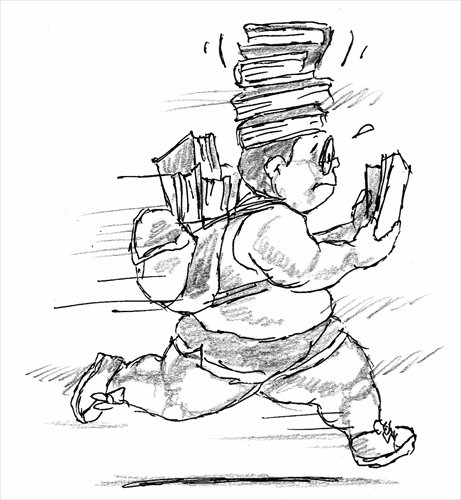Gaokao obsession wrecks students’ health and fun

Illustration: Peter C. Espina/GT
On October 14, over 4,000 teachers and students from a high school in Southwest China's Sichuan Province completed a 1-kilometer-long jog, kicking off a first for physical education campaigns in China.
Pioneered by the Chengdu No.7 High School, the program demands all new entrants joining the school this year run 600 kilometers during their three years of study. Those who fail to finish the target will not be entitled to get a graduation certificate.
The school claimed that this was aimed at helping students to be both physically and mentally healthy. This soon sparked heated discussion, but the majority hailed the campaign.
There have long been public concerns with China's basic education system, which is widely criticized for emphasizing too much on academic excellence.
The stress of preparing for the all-important gaokao, the national college entrance examinations, has forced many schools to downplay physical education.
Instead, they replace physical exercises with various tutoring programs and extra exams, keeping students cooped up in their classroom studying 24/7.
More than 10 years later, I still remember vividly my horrible experience of preparing for gaokao. I am from Shandong Province, a populous region where the competition is particularly fierce. My day started at 7 am and lasted until 10 pm.
The extracurricular sports activities were canceled. And although there were class breaks during the tight schedule of self-study periods and classes, many of my classmates chose to stay in the classroom so that they could snatch an extra few minutes for study.
Educationalists suggest some element of balance is necessary in students' academic lives, and there have always been attempts to reemphasize physical education in China's education system.
Since 2007, the Ministry of Education has promoted the "Sunshine Physical Education" program, making it obligatory for students to do sports at least one hour a day.
However, there is a lack of urgency on the part of the schools to strictly meet the demand, as the education system remains heavily oriented toward the gaokao.
The downplaying of physical education in schools yields a worrying result. The overall health and fitness of Chinese young students have been declining in recent years.
According to a survey by the Beijing Municipal Committee of the Chinese People's Political Consultative Conference in 2013, the blood volume of the 17-year-old students polled, a proxy for some health issues, especially related to obesity, was dropped by 150 milliliters for boys and 48 milliliters for girls compared with 2012.
The survey pointed out that the health of teenagers has been hampered by some chronic diseases that were previously often only considered to strike the adults. 45.1 percent of respondents in the survey were diagnosed with fatty livers, and 30.7 percent had hypertension.
Given these worrying conclusions, it's necessary to promote and enhance physical exercises among Chinese students, especially those junior and senior high school students.
Students are supposed to be full of emotions and vitality. But in China, many have become slaves to exams. Chinese students are often criticized for a lack of creativity.
By demanding the students to clock up a minimum of 600 kilometers within three years in order to graduate, the Chengdu No.7 High School is stimulating students to take physical exercises. This is a laudable move.
However, that students have to run for a graduation diploma instead of for fun is controversial. Some are also calling for including the sports testing into gaokao so that Chinese schools will be forced to promote physical education.
If such a move is really necessary and feasible, it shows how bad our education system has become.
The author is a reporter with the Global Times. yujincui@globaltimes.com.cn